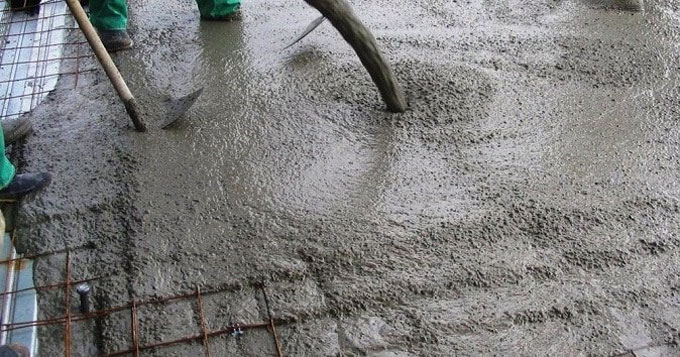
Steps involved in cement concrete works

Given below, brief specifications for executing cement concrete works for different objectives :-
1. Materials for Cement Concrete: Different types of materials cement, aggregates and water are required for cement concrete works. The aggregates are categorized as fine aggregates (sand) and coarse aggregates. The aggregates should comprise of inert material and should be clean, dense, hard, robust, long-lasting, non-absorbent. Besides, it should have the ability to make superior bond with the cement mortar.
Cement - Fresh Portland cement or pozzolana Portland cement (PPC) should be used according to requirement or specification and should contain the necessary tensile and compressive strength and fineness.
Fine Aggregates - Course sand with hard, sharp and angular grains should be utilized as fine aggregate or sand and it should get through 5mm (3/16?) square sieves or mesh. It should contain standard quality and does not contain dust, dirt and organic matters. Sea sand is not recommended for concrete works. Fine aggregates should comprise of crushed stone or manufactured sand if indicated.
Coarse Aggregates - These should comprise of hard broken stone of granite or similar stone and does not contain dust, durst and other foreign materials. The size of stone ballast should remain 20mm (0.75 inches) and less and should be arranged on 5mm (0.25 inch) square mesh. These should be well grades to retain voids under 42%.
The size of coarse aggregate is based on the thickness of concrete and nature of work. As for instance, size of coarse aggregates for building works should remain 20mm and 40mm to 60mm sizes are applied for road work and mass concrete works.
Water - The quality of water should be same as drinking water and it does not contain alkaline and acid matters.
2. Proportioning of Cement Concrete: The proportions in cement concrete should be according to the design and strength requirements. The proportion can be 1:2:4 (M15 concrete) or 1:1.5:3 for M20 concrete. The proportions of 1:2:4 concrete include the ratio of cement: sand: coarse aggregates by volume until indicated. Least compressive strength of concrete of 1:2:4 mix proportion should be 140 kg/sq.cm or 2000 lbs/sq.in on 7 days.
3. Measurement of Materials: Sand and coarse aggregates are calculated by volume with boxes. Cement should not be calculated by box, one bad of cement of 50kg weight should be treated as 1/30 cu.m or 1.2 cu.ft volume. Size of measured boxes may be 30 cm x 30 cm x 38 cm or 35 cm x 35 cm x 28 cm similar to the content of one bag of cement.
All materials should be dry and in case of utilizing damp sand, compensation should be done with extra quantity sand to the extent necessary for bulking of sand.
4. Mixing of Cement Concrete: Mixing of concrete should be done with machine to attain superior quality. For small works, hand mixing by batches is suitable.
5. Checking for Concrete Slump: Slump test should be conducted constantly to control the addition of water and to retain the desired consistency. A slump of 7.5cm to 10 cm (3 inches to 4 inches) is perfect for building work and 4 cm to 3 cm (1.5 inch to 2 inches) is ideal for road work.
6. Formwork for Concrete Works: Formwork centering and shuttering should be arranged as per need and the standard specifications prior to place concrete to confine or to support or to retain the concrete in exact location. The inside surface of the concrete should be oiled with formwork oils so that the concrete can?t stick to it.
Before placing concrete, water should be sprinkled over the base and formwork where the concrete will be arranged. Forms should not be detached prior to 14 days in general, side forms may however be detached after 3 days of concreting.
7. Placing of Concrete: It is necessary to place concrete gently in layers not surpassing 15cm or 6 inches and it should be consolidated by pinning with rods and tamping with wooden tampers or with mechanical concrete vibrating machines unless a solid concrete is produced.
Concrete should be placed constantly. If the placing of concrete is postponed for rest of the day or for the following day, the end should be sloped at an angle of 30 degrees and made rough for jointing again.
Curing of Concrete: After about two hours of placing when the concrete starts to become solid gradually, it should be retained moist by covering with wet gunny bags or wet sand for 24 hours and then curing by flooding with water making mud walls of 7.5 cm or 3 inches high or by covering with wet sand or earth and kept damp constantly for 15 days.


